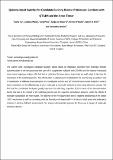Files in this item
Quinone-based switches for candidate building blocks of molecular junctions with QTAIM and the stress tensor
Item metadata
| dc.contributor.author | Xu, Tianlv | |
| dc.contributor.author | Wang, Lingling | |
| dc.contributor.author | Ping, Yang | |
| dc.contributor.author | van Mourik, Tanja | |
| dc.contributor.author | Früchtl, Herbert | |
| dc.contributor.author | Kirk, Steven R. | |
| dc.contributor.author | Jenkins, Samantha | |
| dc.date.accessioned | 2019-08-05T23:41:30Z | |
| dc.date.available | 2019-08-05T23:41:30Z | |
| dc.date.issued | 2018-08-06 | |
| dc.identifier | 253159912 | |
| dc.identifier | f297ca5f-aba5-4985-b9fb-03678977f5ef | |
| dc.identifier | 85052232058 | |
| dc.identifier | 000444678400019 | |
| dc.identifier.citation | Xu , T , Wang , L , Ping , Y , van Mourik , T , Früchtl , H , Kirk , S R & Jenkins , S 2018 , ' Quinone-based switches for candidate building blocks of molecular junctions with QTAIM and the stress tensor ' , International Journal of Quantum Chemistry , vol. Early View , e25676 . https://doi.org/10.1002/qua.25676 | en |
| dc.identifier.issn | 0020-7608 | |
| dc.identifier.other | ORCID: /0000-0001-7683-3293/work/57088473 | |
| dc.identifier.other | ORCID: /0000-0001-6647-4266/work/60887491 | |
| dc.identifier.uri | https://hdl.handle.net/10023/18251 | |
| dc.description | The National Natural Science Foundation of China is acknowledged, project approval number: 21673071. The One Hundred Talents Foundation of Hunan Province and the aid program for the Science and Technology Innovative Research Team in Higher Educational Institutions of Hunan Province are gratefully acknowledged for the support of S.J. and S.R.K. The Royal Society is thanked by S.J., S.R.K, T.X, T.v.M and H.F. for support through an International Exchanges grant. | en |
| dc.description.abstract | The current work investigates candidate building blocks based on molecular junctions from hydrogen transfer tautomerization in the benzoquinone-like core of an azophenine molecule with QTAIM and the recently introduced stress tensor trajectory analysis. We find that in particular the stress tensor trajectories are well suited to describe the mechanism of the switching process. The effects of an Fe-dopant atom coordinated to the quinone ring, as well as F and Cl substitution of different ring-hydrogens, are investigated and the new QTAIM and stress tensor analysis is used to draw conclusions on the effectiveness of such molecules as molecular switches in nano-sized electronic circuits. We find that the coordinated Fe-dopant greatly improves the switching properties, both in terms of the tautomerisation barrier that has to be crossed in the switching process and the expected conductance behavior, while the effects of hydrogen substitution are more subtle. The absence of the Fe-dopant atom led to impaired functioning of the switch ‘OFF’ mechanism as well coinciding with the formation of closed-shell H–––H bond critical points that indicated a strained or electron deficient environment. Our analysis demonstrates promise for future use in design of molecular electronic devices. | |
| dc.format.extent | 4476201 | |
| dc.language.iso | eng | |
| dc.relation.ispartof | International Journal of Quantum Chemistry | en |
| dc.subject | QTAIM | en |
| dc.subject | Quinone-based switches | en |
| dc.subject | Stress tensor | en |
| dc.subject | Stress tensor trajectory | en |
| dc.subject | QD Chemistry | en |
| dc.subject | NDAS | en |
| dc.subject.lcc | QD | en |
| dc.title | Quinone-based switches for candidate building blocks of molecular junctions with QTAIM and the stress tensor | en |
| dc.type | Journal article | en |
| dc.contributor.sponsor | The Royal Society | en |
| dc.contributor.institution | University of St Andrews. School of Chemistry | en |
| dc.contributor.institution | University of St Andrews. EaSTCHEM | en |
| dc.identifier.doi | https://doi.org/10.1002/qua.25676 | |
| dc.description.status | Peer reviewed | en |
| dc.date.embargoedUntil | 2019-08-06 | |
| dc.identifier.url | https://onlinelibrary.wiley.com/doi/10.1002/qua.25676 | en |
| dc.identifier.grantnumber | IE160942 | en |
This item appears in the following Collection(s)
Items in the St Andrews Research Repository are protected by copyright, with all rights reserved, unless otherwise indicated.

